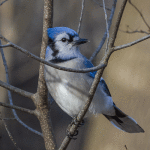
Blue Jay in Winter
I was very happy we didn’t get the brutal cold from the polar vortex that hit the eastern U.S. but it did get me thinking about how birds stay warm in the winter. It’s a common misconception that if you put up a box, birds will use it at night for sleeping, but it just isn’t so. Birds mostly use boxes to nest. They roost in dense thickets where the thick tangles of vegetation or evergreen boughs protect them from rain, cold and predators.
Feathers, of course, are another way birds keep warm. They are very efficient insulation as you may have discovered if you have a down jacket. By fluffing their feathers birds create air pockets that trap heat and reduce heat loss. Watch the birds when it’s really cold out and you will see that they are all fluffed out as they utilize these feather capabilities. Birds also have an oil gland just above their tail and they spread this oil over their feathers to make them waterproof. This keeps rain from soaking through their feathers so they don’t succumb to hypothermia. They spread the oil by rubbing their head in the area just above their tail and then rubbing their head on other parts of their body.
As a general rule, larger birds are better able to deal with cold weather than smaller birds because the larger body allows them to retain heat better. Because of this over winter survival is tougher for small birds because they lose heat fairly quickly and relative to their size they need to eat more food to keep warm. Some birds prepare for winter by caching food during the warmer months to be consumed during the winter. Unfortunately other birds and animals can find these hidden away stores and deplete them.
Hummingbirds use another method to survive cold winter nights. They can go into a temporary hibernation mode called torpor to help them conserve energy. Birds in torpor reduce their body temperature along with their metabolism rate which saves energy because they don’t have to maintain normal body temperature. Without this mechanism hummingbirds would die overnight in winter because they cannot store enough food to produce the energy needed to keep them warm overnight.
Birds keep their feet and beaks warm by burying them in their feathers. This is critical because exposed feet and beaks lose a lot of heat similar to humans not wearing a hat or gloves. This is why birds often sleep standing on one foot holding the other foot tightly against their body. Waterbirds use a mechanism called counter current exchange to heat the cold blood coming from their feet and cool the warm blood going to their feet so they aren’t losing a lot of heat to the cold water. This allows them to stand in cold water for long periods of time without the cold transferring to their core and thus making them cold all over.
Of course you can also help out the birds by placing a birdfeeder (or two) and a birdbath in your yard. High energy feeder foods include black oil sunflower seeds, thistle seed, or suet. You’ll enjoy their antics on cold winter days!
Sue Heath is the Director of Conservation Research of the Gulf Coast Bird Observatory.
